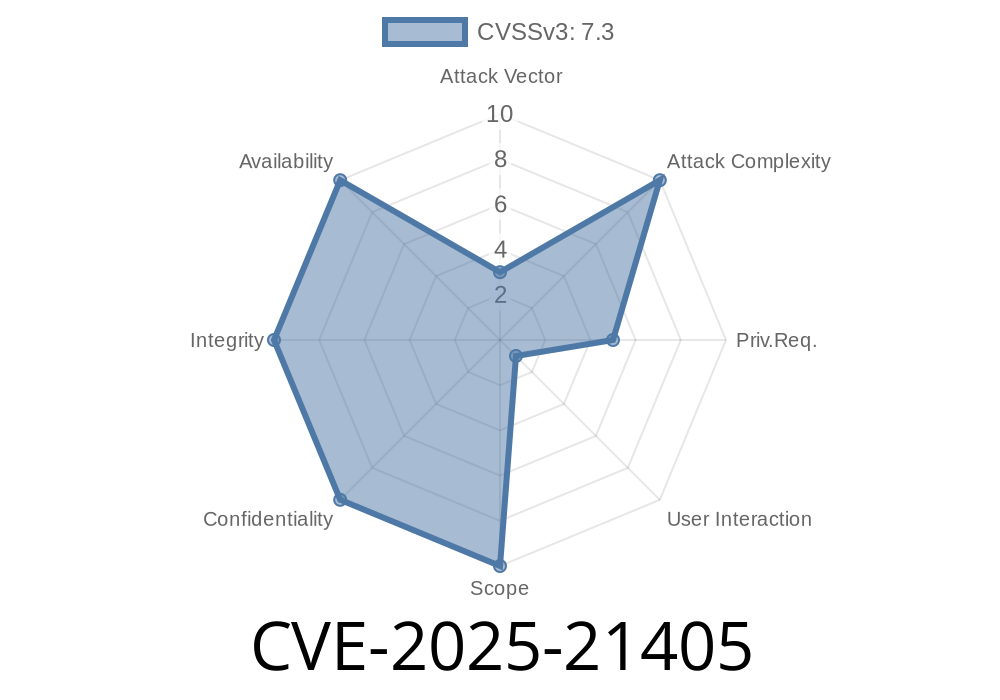A new security vulnerability has been discovered and assigned to CVE-2025-21405, which targets users of Microsoft Visual Studio, a popular integrated development environment (IDE) used for developing computer programs, web sites, web applications, web services, and mobile applications. It allows malicious actors to leverage a flaw in the system to elevate their privileges to gain unauthorized access to resources. This blog post will examine the details of this vulnerability, provide code snippets to illustrate the problem, and offer recommendations on how to address the issue.
Vulnerability Details
CVE-2025-21405 is a "privilege escalation" vulnerability in Visual Studio, which can enable an attacker to gain elevated privileges on a user's system. When exploited, hackers can run malicious code with system-level permissions, allowing them to execute actions that a regular user would not be able to perform, such as creating, altering, or deleting files and folders, modifying system settings, and even gaining access to sensitive data.
This vulnerability is caused by a flaw in the handling of environment variables by Visual Studio when building or debugging a project. An attacker can manipulate certain environment variables in a way that causes Visual Studio to load untrusted code from an arbitrary directory, which will then be executed with higher privileges. The attacker must already have access to the initial set of environment variables and perform this attack in the context of the targeted user to be able to execute arbitrary code.
Exploit Overview
To illustrate the problem, let's take a look at a code snippet that demonstrates how this vulnerability could be exploited. Here's a simple example of a malicious script that an attacker might use:
import os
# Set the malicious environment variables
os.environ['VS_CHROME_WRAPPER_ENV_OVERRIDE'] = '\\path\\to\\malicious\\config\\file'
os.environ['VS_SETUP_DOTNET_CHROME_WRAPPER'] = '\\path\\to\\malicious\\binary'
# Launch Visual Studio, which will execute the malicious binary
os.system("C:\\Program Files (x86)\\Microsoft Visual Studio\\Installer\\vs_installer.exe")
The script sets the environment variables VS_CHROME_WRAPPER_ENV_OVERRIDE and VS_SETUP_DOTNET_CHROME_WRAPPER to point to a malicious configuration file and binary, respectively. When Visual Studio is launched, it reads these environment variables, loads the malicious binary, and executes it with elevated privileges.
Official References
Microsoft has recognized this as a significant security problem, and they issued their official security advisory here. Additionally, the CVE can be seen with more technical details at the following Mitre link: CVE-2025-21405
Mitigation Techniques
Although there is currently no official patch available for this vulnerability, the risk can be reduced by taking the following steps:
1. Limit user access: Restrict the number of users who have privileges to modify environment variables. This is achieved through access control settings.
2. Apply the latest patches and updates: Regularly update all software, especially Visual Studio, to help protect your system from unpatched security vulnerabilities.
3. Monitor your environment: Keep an eye on any changes to your environment variables and the files and folders they point to, ensuring they remain safe and trusted.
4. Use the Principle of Least Privilege (POLP): Make sure that users on a system have only the minimum permissions necessary for their job functions. This reduces the potential damage caused by a privilege escalation vulnerability.
Conclusion
CVE-2025-21405 is a dangerous vulnerability in Visual Studio that requires your immediate attention. By understanding and addressing the security risks mentioned above, you can help keep your systems safe and secure. Remain vigilant when monitoring your environment and always maintain up-to-date software and security practices.
Timeline
Published on: 01/14/2025 18:16:04 UTC
Last modified on: 02/14/2025 23:40:30 UTC
